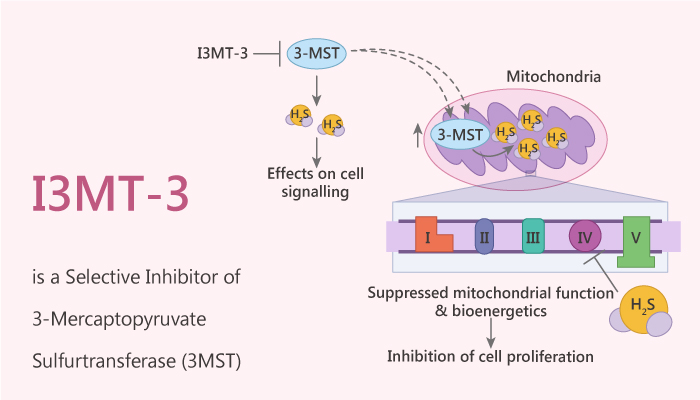The endogenous gaseous transmitter hydrogen sulfide (H2S) is involved in multiple regulatory processes in mammalian cells in health and disease.
In mammalian cells, there exists at least 3 H2S-sourced enzymes: Cystathionine-beta-synthase (CBS), cystathionine-gamma-lyase (CSE), and 3-mercaptopyruvate sulfurtransferase (3MST).
In cancer cells, CBS, CSE, and/or 3-MST are the enzymatic sources of H2S. Among these three enzymes, the function of the 3-MST system needs more attention.
In this article, we will introduce a potent 3-Mercaptopyruvate sulfurtransferase (3MST) inhibitor, I3MT-3.
I3MT-3 is a potent, selective, and cell-membrane permeable inhibitor of 3-Mercaptopyruvate sulfurtransferase (3MST) (IC50=2.7 μM).
Besides, I3MT-3 is inactive for other H2S/sulfane sulfur-producing enzymes. This compound targets a persulfurated cysteine residue located in the active site of 3MST.

In cell lysate of 3MST-overexpressing HEK293 cells, I3MT-3 is selective for 3MST and shows a high inhibitory activity (80–90%) even at 10 μM. Additionally, it is almost inactive towards the other two H2S-producing enzymes even at 100 μM.
In COS7 cells living cells, I3MT-3 shows high selectivity for 3MST, it completely suppresses the 3MST activity.
I3MT-3 produces a concentration-dependent inhibition of the AzMC (the fluorescent H2S probe) signal when incubated with the purified human recombinant enzyme.
The inhibition of the catalytic activity of 3-MST produces a concentration-dependent inhibition of H2S production with an IC50 of 13.6 µM.
This compound also shows dose-dependent inhibition of 3-MST activity from CT26 homogenates, which contain the murine form of the enzyme. The IC50 of HMPSNE for murine 3-MST is 2.3 µM with a concentration-dependent decrease of AzMC fluorescence.
Furthermore, I3MT-3 causes partial inhibition of the signal at 10 µM. While at 100 µM, HMPSNE causes a complete inhibition of the AzMC-guided H2S fluorescence. Additionally, HMPSNE is capable of inhibiting its target in situ in CT26 cells (with an IC50 of approximately 30 µM). I3MT-3 does not enhance MTT conversion at 10 µM. However, when it at high concentration, 100 µM and 300 µM it produces an inhibitory response, without increasing the LDH signal. It also produces a decreased oxygen consumption rate (OCR) profiles in CT26 cells.
Lastly, in CT26 cells, I3MT-3 inhibits CT26 cells proliferate with increasing concentrations of I3MT-3. The confluence of cells treated with HMPSNE is recorded each hour for 48 h by the IncuCyte method. In a word, I3MT-3 slows down the proliferation of CT26 cells.
In conclusion, I3MT-3 is a promising 3MST inhibitor and is useful in the regulation of proliferation, migration, and bioenergetics in cancer cells.
Reference:
[1]. Kenjiro Hanaoka, et al. Sci Rep. 2017 Jan 12;7:40227
[2]. Fiona Augsburger, et al. Biomolecules. 2020 Mar 13;10(3):447.